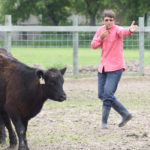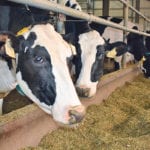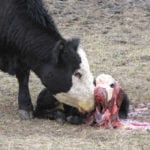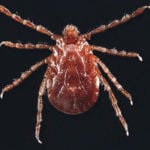I’ve been hearing many complaints from cattle producers and veterinarians about major issues with cattle and potential external parasites this winter. This year there seems to be an exceptionally high number of complaints about this issue, and in many cases the problem is associated with lice infestations. There are two specific types of lice that […] Read more
Stories by John Campbell, DVM, DVSC
PED virus demonstrates why biosecurity needed
The latest case of a porcine epidemic diarrhea virus outbreak in Alberta emphasizes the immense importance of strong biosecurity protocols for livestock operations. Pork producers have some of the strictest biosecurity protocols of any livestock sector in Canada and they are continuing to try to improve their biosecurity practices and emergency response planning in an […] Read more

Are your animal handling skills ‘above average?’
It’s a well described phenomenon. If we randomly ask a group of people to rate their driving skills, the majority will rate themselves as above average. Of course, this can’t be true. Some of us are just average drivers and some of us are somewhere below the average. Psychologists describe this cognitive bias as “illusory […] Read more
Is it possible to use technology to identify calving cows sooner?
The calving season is just around the corner for many seedstock producers, and producing and weaning live calves are critical to cow-calf profitability. Problems at this time of year can have significant consequences. The birthing period and the subsequent first few days of life have been shown to be the most hazardous time of a […] Read more

Breeding bulls may be source of bovine leukosis virus
Bovine leukosis virus is a widespread viral infection in cattle in North America. Dairy cattle tend to have a higher level of infection with estimates of 14 percent of all dairy cows being infected with the virus. Older cows are often more likely to be infected. The virus is usually spread from animal to animal […] Read more
Bibersteinia trehalosi can cause sudden deaths in heifers
Imagine you go out to check some heifers and find one animal has died suddenly. All of the animals looked great yesterday and there have been no recent illnesses or treatments. They have all been on a good vaccination program and seemed to be doing fine. We might suspect bloat or lightning, but there is […] Read more

The strange case of the low-birth-weight calves
Several years ago, the Disease Investigation Unit at the Western College of Veterinary Medicine in Saskatoon was asked to investigate an unusual herd problem on a ranch near the end of calving season. A large proportion of the heifers on this ranch had given birth to calves with birth weights of 30 to 40 pounds […] Read more
Feed shortage makes nutrition management more vital
Significant areas of Western Canada are affected by feed shortages and drought, which means many producers are faced with difficult management decisions for their herd in the coming year. Many producers will have to consider alternative and even unusual feed sources for both the fall and winter. I’ve seen media reports on the importance of […] Read more

Longhorned tick arrival shows need for surveillance
Ticks come in two basic varieties. The so-called “hard ticks” are from the family known as Ixodidae and are characterized by a hard plate on their backs. Soft ticks (family Argasidae) lack this hard, protective plate and are usually more oval or pear-shaped. Ticks can carry a variety of infectious diseases and can infect humans, […] Read more
High mountain disease growing problem in feedlot cattle
Heart failure in cattle is most often caused by conditions such as hardware disease or bacterial endocarditis or myocardial infections with the Histophilus somnus bacteria. Very young calves may suffer from heart failure due to congenital defects. However, there is a very unique condition that can cause right-sided heart failure in cattle known as high […] Read more



